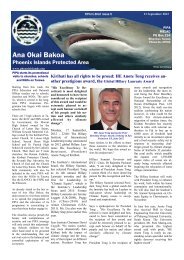Nomination for a World Heritage Site 2009 - Phoenix Islands ...
Nomination for a World Heritage Site 2009 - Phoenix Islands ...
Nomination for a World Heritage Site 2009 - Phoenix Islands ...
Create successful ePaper yourself
Turn your PDF publications into a flip-book with our unique Google optimized e-Paper software.
This layer is the domain of many fish species such as tuna, many sharks, dolphin fish, and<br />
jellyfish.<br />
Mesopelagic zone reaches from 200 meter to about 1000 meters depth. Although some light<br />
penetrates this deep, it is insufficient <strong>for</strong> photosynthesis. At about 500 m the water becomes<br />
depleted of oxygen. Still, an abundance of life copes with more efficient gills or minimal<br />
movement. Animals such as swordfish, squid, wolffish, a few species of cuttlefish, and other<br />
semi-deep-sea fauna can be found in this zone.<br />
Below 1000 meters depth starts the deep sea area where very little or no light penetrates.<br />
Most of its organisms rely <strong>for</strong> subsistence on falling organic matter (known as ‘marine<br />
snow’) and carcasses derived from the productive zone above. For this reason it was assumed<br />
life would be sparse in these great depths, but virtually every probe has revealed that, on the<br />
contrary, life is abundant in the deep sea. To date the deep sea represents one of the least<br />
explored areas on Earth, it is less known than the moon. The deep sea has been divided into<br />
bathypelagic, abyssopelagic and hadopelagic zones.<br />
Bathypelagic zone extends from a depth of 1000 to 4000 meters below the ocean surface. The<br />
average temperature is about 4 ºC. Although larger by volume than the above euphotic zone,<br />
the bathyal zone is less densely populated. Sunlight does not reach this zone, meaning there<br />
can be no primary production. Many <strong>for</strong>ms of nekton live in the bathyal zone, such as squid,<br />
viperfish, deepwater sharks, large whales, and octopuses. Sponges, brachiopods, sea stars,<br />
and echinoids are also common in the bathyal zone. The fish in this zone have become very<br />
energy efficient. Many have slow metabolic rates, to conserve energy. By volume the<br />
bathypelagic zone is the most widespread habit in PIPA.<br />
Abyssopelagic zone extends from 4,000 to 6,000 meters and contains the very deep benthic<br />
communities near the bottom of oceans. This zone remains in perpetual darkness and never<br />
receives daylight. Species found in this zone include the Black swallower, tripod fish, deepsea<br />
anglerfish and the giant squid which are able to withstand the immense pressures of the<br />
ocean depths, up to 76 megapascals (11,000 psi – pounds per square inch). The deep trenches<br />
or fissures that plunge down thousands of metres below the ocean floor are almost<br />
unexplored. These regions are also characterized by continuous cold and lack of nutrients.<br />
The abyssal zone has temperatures around 2 to 3 ºC.<br />
Hadopelagic zone is the delineation <strong>for</strong> the deepest trenches in the ocean. This zone is found<br />
from a depth of around 6,000 meters to the bottom of the ocean. The pressure can reach over<br />
1,100 standard atmospheres (110 MPa /16,000 psi). The most common fauna include<br />
jellyfish, viperfish, tube worms, clams, and the deep sea angler fish.<br />
The deep sea species have a number of ways to adapt to these extreme conditions. For<br />
example the midwater fish are small, usually under 25cm; they have slow metabolisms and<br />
unspecialized diets, preferring to sit and wait <strong>for</strong> food rather than waste energy searching <strong>for</strong><br />
it. Because of the sparse distribution and lack of light, finding a partner with which to breed<br />
is difficult, and many organisms are hermaphroditic.<br />
It is noteworthy that globally the ocean floor between 4,000 m and 6,000 m is the single most<br />
extensive natural habitat, representing about 60% of the surface of the planet.<br />
47





